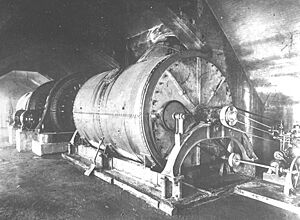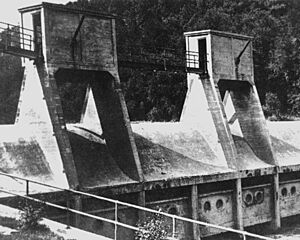Bloede's Dam facts for kids
Quick facts for kids Bloede's Dam |
|
|---|---|
| Official name | Bloede's Dam |
| Location | Catonsville / Ilchester, Maryland |
| Coordinates | 39°14′49″N 76°45′40″W / 39.247023°N 76.761083°W |
| Opening date | 1907 |
| Demolition date | September 2018 |
| Operator(s) | Maryland DNR |
| Dam and spillways | |
| Impounds | Patapsco River |
| Height | 26+1⁄2 feet (8.1 m) |
| Length | 220 feet (67 m) |
| Width (base) | 40 feet (12 m) |
Bloede's Dam was a special kind of dam on the Patapsco River in Maryland. It was built to make electricity using the power of water, which is called hydroelectric power. What made this dam so unique was that its power plant was actually built *under* the water. It was right beneath the dam's spillway, making it the first known underwater hydroelectric plant. It was also one of the earliest dams ever made using strong, reinforced concrete. Today, the area where the dam once stood is part of Patapsco Valley State Park Avalon Area.
How It Was Built and Used
In 1906, a company from Ellicott City made history. They built the world's first underwater hydroelectric plant on the Patapsco River. The dam was named after Victor Gustav Bloede, who was the company's president.
Mr. Bloede hired an expert called Otto Wonder to help design this amazing project. The dam itself was about 220 feet (67 meters) long. It was 40 feet (12 meters) wide at its base and the water dropped 26.5 feet (8.1 meters) over it. It was built using a special type of reinforced concrete.
The machines inside the dam were very modern for their time. They included large "Leffel Wheels" and two powerful "Samson Turbines." These machines could create 11,000 volts of electricity. A long "fish ladder" was also built to help fish swim past the dam.
Powering Local Towns
The plant was meant to provide electricity to nearby towns. These included Illchester, Ellicott City, and Catonsville. Many of these towns did not have electricity yet. The new plant replaced an older, smaller one.
On November 28, 1908, the new electric equipment started working. Victor Bloede's daughter, Miss Vida Bloede, helped turn it on. About 500 important guests came to celebrate. They even served waffles made with electric waffle makers!
Changes Over Time
Later, the dam was sold to a larger electric company in 1913. It continued to make electricity until 1924. By then, bigger and more powerful plants were being built, so Bloede's Dam was no longer needed for power.
In 1938, the land was sold to the State of Maryland. The dam was badly damaged by a big flood during Hurricane Agnes in 1972. Even though much of it was still standing, it was mostly an empty shell. In 1992, a new, improved fish ladder was added. This helped fish like American eels swim upstream past the dam.
Why the Dam Was Removed
The removal of Bloede's Dam began in September 2017. The main goal was to finish the work by spring of 2019. One reason for removing it was to uncover and take out a long sewer pipe. This pipe was sitting on silt that had built up behind the dam.
Another important reason was safety. Nine people had died at the dam since the 1980s because it was a dangerous spot. Removing it would create a safer, shallow, rocky area. This new area would be great for activities like kayaking.
Two other dams upstream from Bloede's Dam were removed in 2010. With Bloede's Dam gone, Daniels Dam is now the last remaining dam on the main part of the Patapsco River.



